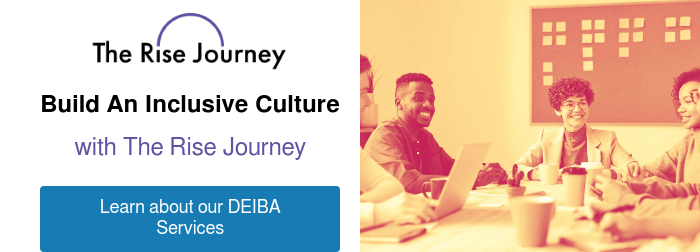How to Elevate Your DEIBA Practices to Eliminate Discrimination in the Workplace
76 percent of American workers believe racism and discrimination is an issue at U.S. workplaces. Only 44 percent think it is a problem at their company, according to Clutch’s 2020 Diversity and Inclusion Survey.
Why does this discrepancy exist? How can you ensure that your organization is doing enough to address and eliminate discrimination in the workplace? How can your organization demonstrate commitment to Diversity, Equity, Inclusion, Belonging, and Accessibility (DEIBA)?
Use 5 Simple Tips to Boost Diversity, Equity, Inclusion, Belonging & Accessibility Initiatives (DEIBA)
Make sure your organization has a clear understanding of DEIBA
The ultimate goal is equity, not just diversity. Having employees from different backgrounds is a step in the right direction. This alone will not solve or address the underlying issues that perpetuate workplace inequality. Without a commitment to equity, diverse employees will leave in search of better opportunities and advancement.
Look at your current Diversity, Equity and Inclusion (DEI) approach and consider conducting a DEI organizational assessment (also known as an employee engagement survey). This tool is one of the most effective methods to understand the strengths and weaknesses of your company’s DEI initiatives. It will help your leaders to identify short and long-term goals, and allow opportunities to learn from employee feedback.
Demonstrate leadership commitment to upholding DEIBA values & practices
Seek out new thought partners and opportunities for learning. Consider organization-wide DEI Lunch & Learn sessions or DEIBA workshops. Meet and consult with experts on how to address areas you may be overlooking. Ask yourself how you can do better to learn and grow as an organization and as people.
Without tangible proof that your organization prioritizes DEIBA, diversity initiatives will feel inauthentic to clients, customers, and employees alike. An organization’s leadership needs to show that they value DEIBA practices through action and continuously engage with DEIBA topics as a learning process rather than something to cross off a checklist.
Avoid excessive shame or blame when areas of improvement are identified, but take responsibility for your mistakes and address them with a commitment to improve. Focus on how you can do better, create a plan with action steps, and identify experts who can help to ensure internal change occurs. Monitor and update your current DEIBA practices. Make sure you aren’t missing out on new approaches to foster innovation and inclusivity that will attract diverse talent and clients. Setting a good example from the top is one of the quickest ways to boost diversity within a workplace and position your organization as DEIBA-centric.
Prioritize inclusion
Diversity is about more than employing people of different racial backgrounds. It also applies to socioeconomic status, gender, education, disability, LGBTQIA+ identity, and more. Ensuring your organization is committed to a welcoming and inclusive environment is key for people to feel accepted and respected long after they’ve been initially hired.
Focus on pay parity. US Census data from 2016 indicates that women and people of color are paid less than white men for the same work. Identifying and addressing the circumstances that facilitate unfair compensation practices works towards the elimination of pay gaps.
Equalizing pay and role levels is a huge part of achieving equality. Ensuring that people are paid the same for the same work, given raises and promotions based on a clear set of guidelines, and that discrimination has no home within these structures is instrumental for talent retention. Are people allowed to be authentically themselves at work? Is diversity celebrated at your organization through a sense of community or DEI Employee Resource Groups (ERGs)? Are your ERG leads being paid? Are people able to bring up and discuss potentially uncomfortable topics to management or their peers?
Build an accessible hiring and interview process, paying close attention to how job descriptions are written and how they could be more inclusive. Are you finding candidates through different hiring platforms like Chronically Capable, DiversifyTech, or other job boards that cater to underrepresented people? Are the images and language representing your organization falling prey to stereotypes or tokenism?
Think deeply about the candidates you want to hire, why you want to hire them, and what makes them excited about your organization.
Diversity isn’t enough without inclusion, and both are key to the long-term success of DEIBA initiatives. According to the American Sociological Association, diverse companies bring in 15 times more sales revenue than companies with lowest levels of diversity. Your employees and your sales will thank you.
Encourage DEIBA training
Participation in organization DEIBA training sessions should be easily accessible and highly prioritized. One way to accomplish this is to make training inclusive. Be sure to have captions, subtitles, photo descriptions, as well as audio and video options (not just one or the other). The more inclusive training is, the more people are likely to participate and learn from it in their own style and at their own pace.
Make space for open discussion
Bring in guest speakers from underrepresented backgrounds to talk about current event topics and issues beyond their marginalized identity. Think about the role of intersectionality and cultivate opportunities for safe discussion where people can bring up DEIBA topics as well as concerns regarding management, performance, setting boundaries at work, ERGs, etc. Making room within an organization to have difficult conversations allows issues to be addressed when they arise, but also as needed.
Be understanding. Respect that people might not want to talk, or may need time to process, which is perfectly normal and okay. Speak out as a leader and share where you are concerned and worried. Have consistent conversations and do not let difficult topics that impact your employees disappear just because it may be easier than addressing them. Open communication is essential at all times, but especially in times of eliminating discrimination in the workplace, hardship or crisis.
Connect with our team to learn how The Rise Journey can help ensure your DEIBA initiatives will work to lead your organization to success.

